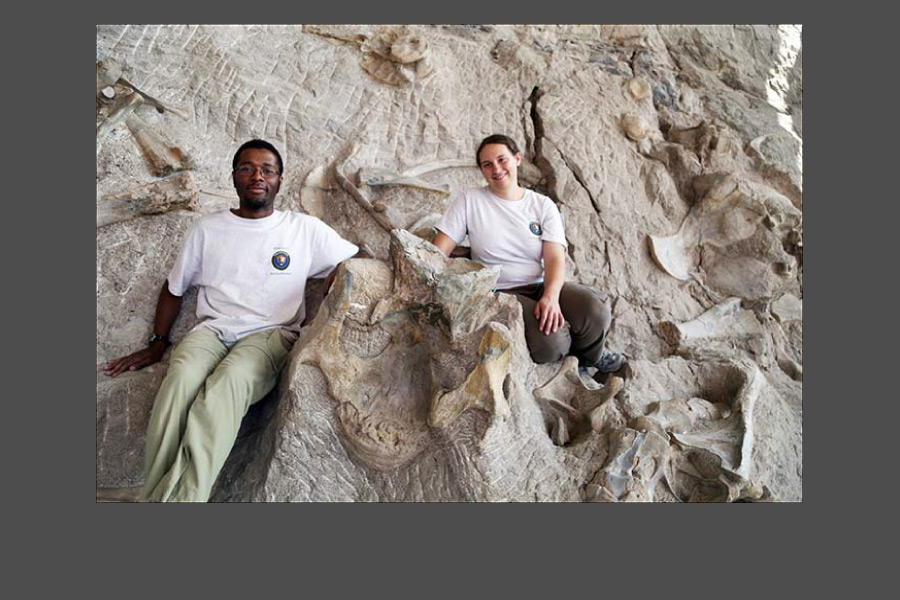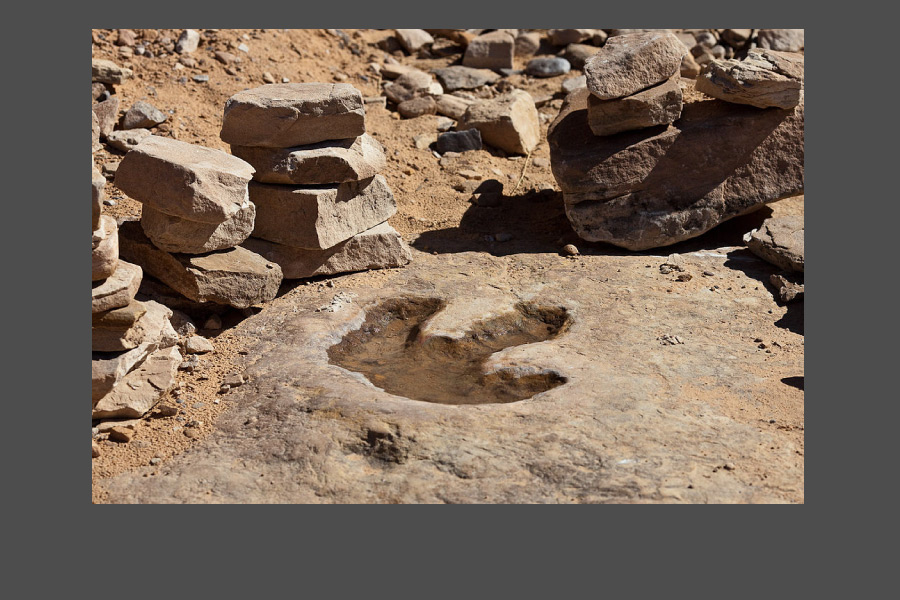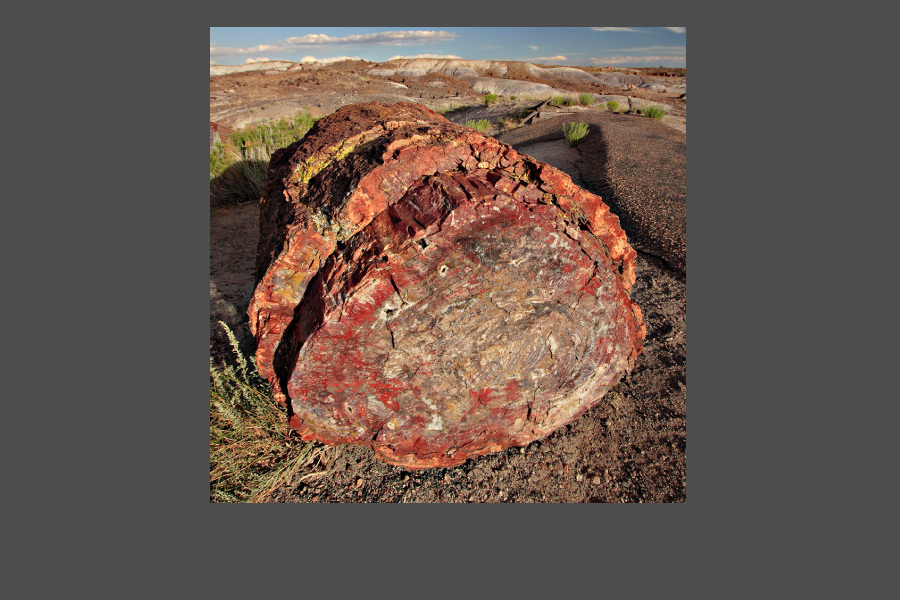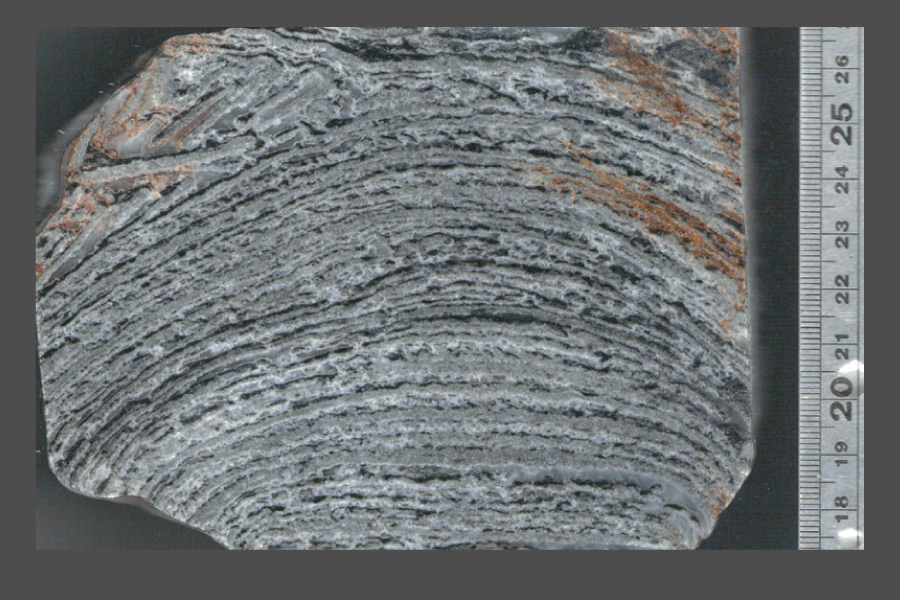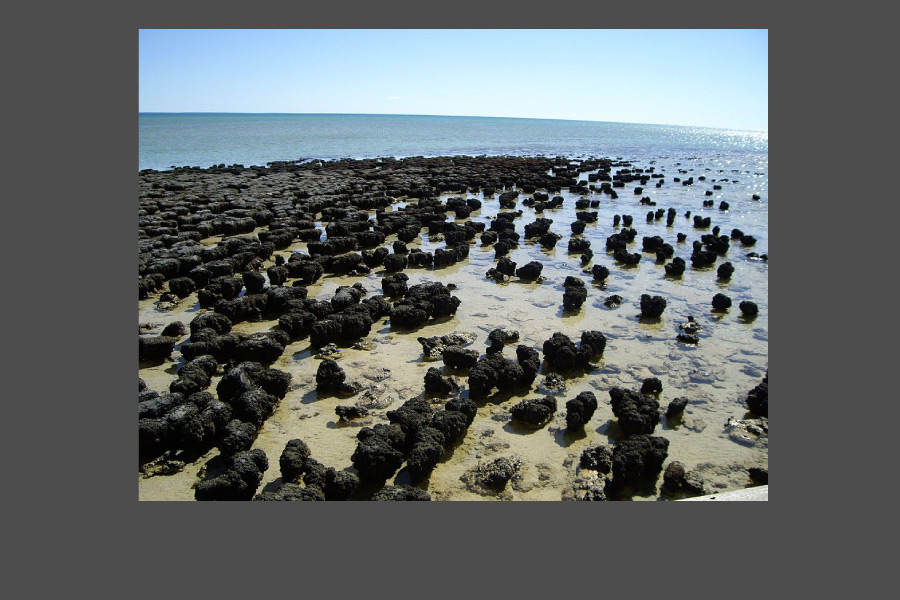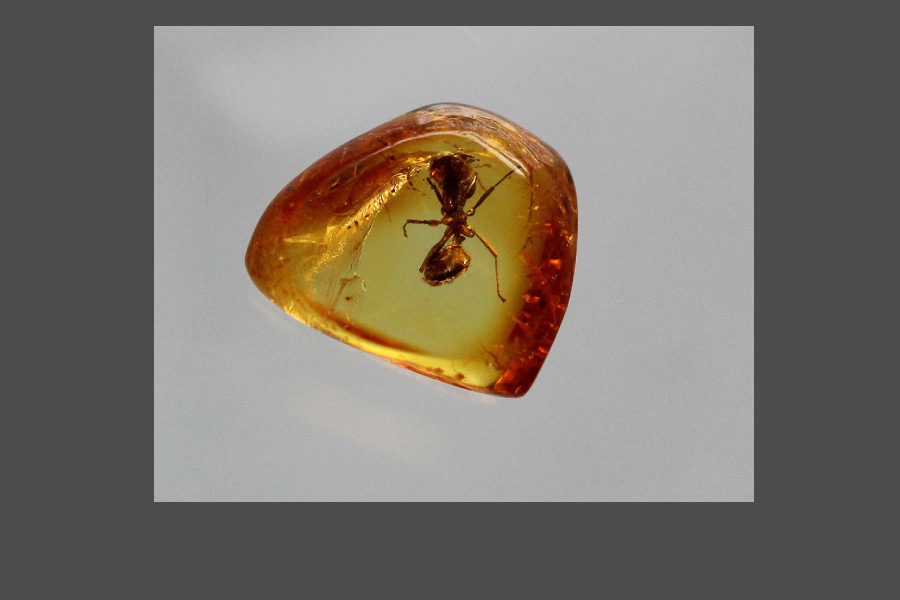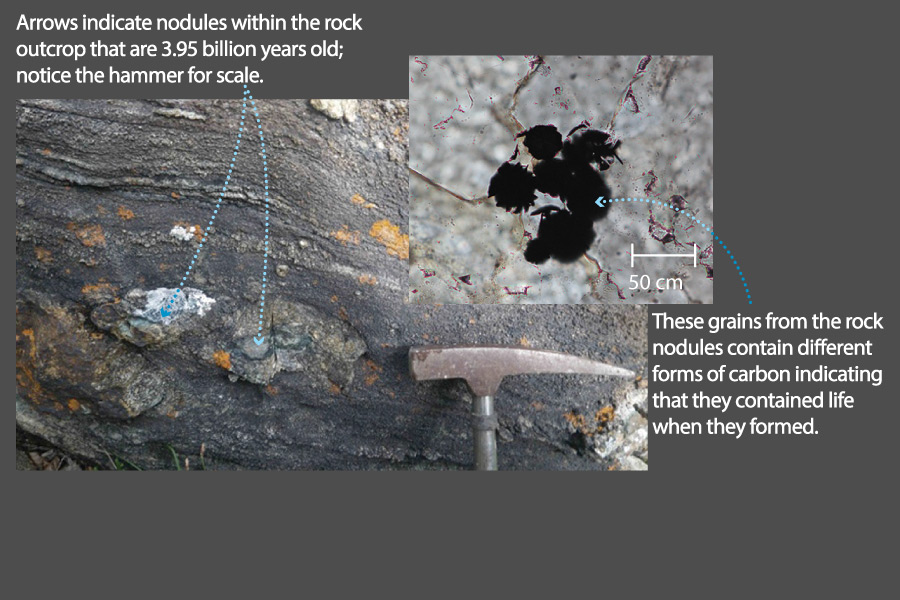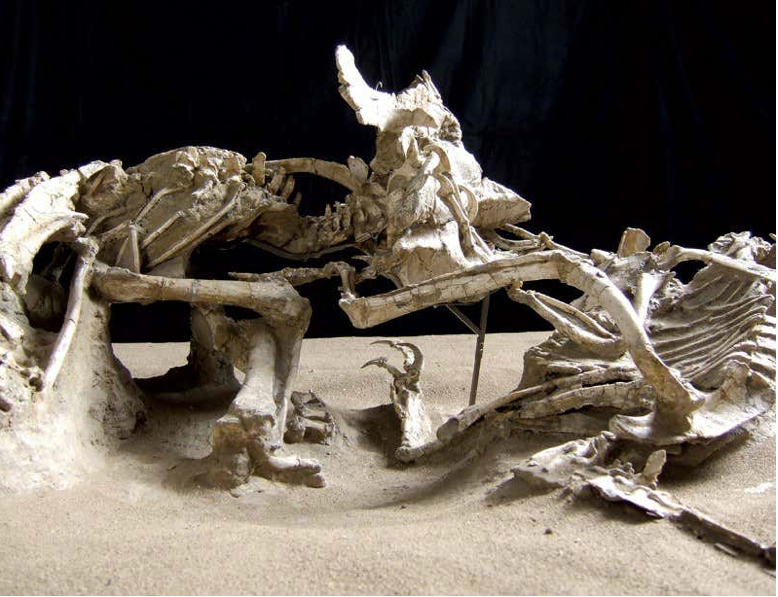Much of what we know about Earth’s history comes not just from studying rocks themselves, but from studying the fossils that are often found within them. You are probably aware that fossils represent living creatures that died long ago. But fossils come in many different types, and very few of them actually contain any of the once-living (“organic”) matter that existed in the living organisms themselves. So what exactly is a fossil? Simply defined:
Types of Fossils
If someone asks you to “picture a fossil,” you’ll probably picture a fossil skeleton, like the skeletons of the “fighting dinosaurs” in Figure 5.1–1 But these are only one of many types of fossils. Slide show 5.1.2–1 shows some of the many different types of fossils that scientists have identified.
Slide show 5.1.2–1 – A few of the many different types of fossils that scientists have identified.
As you study the slide show, note that it is quite rare to find fossils of entire organisms. The only time we find entire organisms is when they somehow got preserved quite quickly. For example, we might see insects preserved in amber because they got stuck in tree sap before they died (amber is fossilized tree sap), or mammoths that froze to death and were preserved in ice or frozen ground in Arctic regions.
More commonly, for animals at least, we see fossils of bones, teeth, or shells, which represent the “hard parts” of these organisms. Many other fossils are impressions (or “casts”) that show what an organism looked like on the outside, such as an impression of a leaf or of a sea shell.
Sometimes, fossils don’t come from any “remains” at all, but instead show evidence that a creature had been present. These include fossilized tracks left in mud by dinosaurs and burrows hollowed out by small mammals. Scientists even find fossilized “poop” (called coprolites), which might sound unappealing but is scientifically important because it can tell us about the diet of the animal that made it.
Scientists face a larger challenge when looking for fossil evidence of very early life, because this life was almost all single-celled, which means it couldn’t leave behind easily-identifiable fossils like bones or teeth. Sometimes scientists can find microfossils — meaning fossils that require a microscope to see them — of these tiny organisms. More often, scientists can find fossils of large groups of these organisms. For example, rocks known as stromatolites have both a structure and chemical content that tells scientists they are the fossilized remains of large colonies of microorganisms.
The very earliest life is not expected to have left any fossilized remains that we are likely to find. However, scientists have found another type of fossil evidence that can help identify this life. All life on Earth contains carbon, but there is more than one different form (“isotope”) of carbon in nature, and the amounts of these types of carbon found in life is different than it is in nonliving material (because life incorporates the different forms of carbon slightly differently through the process of metabolism ). Therefore, when scientists find ancient rocks that have carbon in the amounts expected for life, they can infer that these rocks probably contained living organisms that died long ago. The last slide in Slide Show 5.1.2–1 shows a rock containing what may be the oldest evidence of life on Earth.
Fossil Formation and Preservation
The vast majority of living organisms do not become fossils. Instead, they are completely eaten by other organisms or completely decay in the soil or oceans, leaving no trace of their existence. So how does a living organism get “lucky” enough to become a fossil that can be found millions of years later?
In most cases, fossils form when an organism dies and is fairly quickly buried in sediments. This limits the time it has to decay, so that its “hard parts” — such as bones, teeth, or shells — may remain in the sedimentary layers. Over time, water seeps into these structures, helping minerals to crystallize within them. The result is that, even though what we find millions of years later still looks like the original bones or teeth or shells, it has actually become a mineral replacement of the original material. Figure 5.1.2–2 summarizes the process by which common fossils are formed.
Key Concepts: Fossilized Remains
Dinosaur bones and other similar fossils may look like the actual remains of living organisms, but in most cases, all of the once-living matter has been replaced with minerals that formed as water seeped into the bones (or other structures). In other words, the fossils are not the bones themselves, but instead are stone replicas of the original bones.

Activity
Fossilization Game
Imagine that you are an animal living millions of years ago, and you hope to become a fossil that humans might someday find. As you learned above, your chances aren’t good: It will take a lot of “luck” to become a fossil instead of having your body completely decay. To learn a little more about the various ways in which you’ll need to be lucky, split up into groups of 3 or 4 students and print out one copy of this game board for each group. Then follow the instructions and play the game. When you are done, briefly discuss what you learned. Can you now explain why we can find fossils only from a tiny fraction of all the creatures that have lived on Earth in the past?
- Prepare: Each player needs a small marker to place on the board; you can use any small object, or make your own mini-fossil out of clay. You’ll also need a single die for all the players to share.
- Get ready: Each player should put their marker in Space 1 (“start here”).
- Choose order: Each player should toss the die once. The player who rolls the highest number will go first, the second-highest number will go second, etc. If two players tie on the first roll, then roll again (as many times as necessary) to break the tie.
- Play: When it is your turn, toss the die and move the corresponding number of spaces. When you land on your new space, read it aloud for the group and follow any instructions it gives about moving forward or backward.
- Keep playing until someone “wins” by becoming a fossil.
This game, created by the Oxford University Museum of Natural History, should be a fun way to help students understand the difficulty of fossil formation. It works best with groups of 3 or 4 students, so that the game “board” isn’t too crowded and taking turns doesn’t take too long.
The Fossil Record
The sum total of all discovered fossils represents the fossil record , and it tells us a lot about the history of life on Earth and about Earth itself. Remember that sediments are laid down in layers, or strata , in which the youngest ones are at the top and the oldest ones at the bottom.
In the youngest strata, we find fossils both of species that still survive today and of species that became extinct relatively recently. As we go deeper, we find fossils of species that went extinct longer ago. By comparing the species that existed at different times, we learn how life has evolved and how conditions on Earth have changed with time.
No single location on Earth contains a complete fossil record, meaning a record that spans all periods of time in Earth’s history. However, scientists have been able to put together a fairly complete record by comparing fossils found in different places. Figure 5.1.2–3 illustrates how scientists do this type of “fossil correlation.” In the example shown, the upper layers (strata) of Location 1 contain the same types of fossils that we find in lower layers of Location 2. We can infer that the ages of those layers are the same (since they contain the same fossils), and therefore the two locations together provide a longer fossil record than either location individually.

Fossil Fuels
When we think about fossils and the fossil record, we usually think about the kinds of fossils that we see in museum. But there’s another type of fossil that we see or use almost every day: the fossils that make up fossil fuels : coal, oil (petroleum), and natural gas (Figure 5.1.2–4).
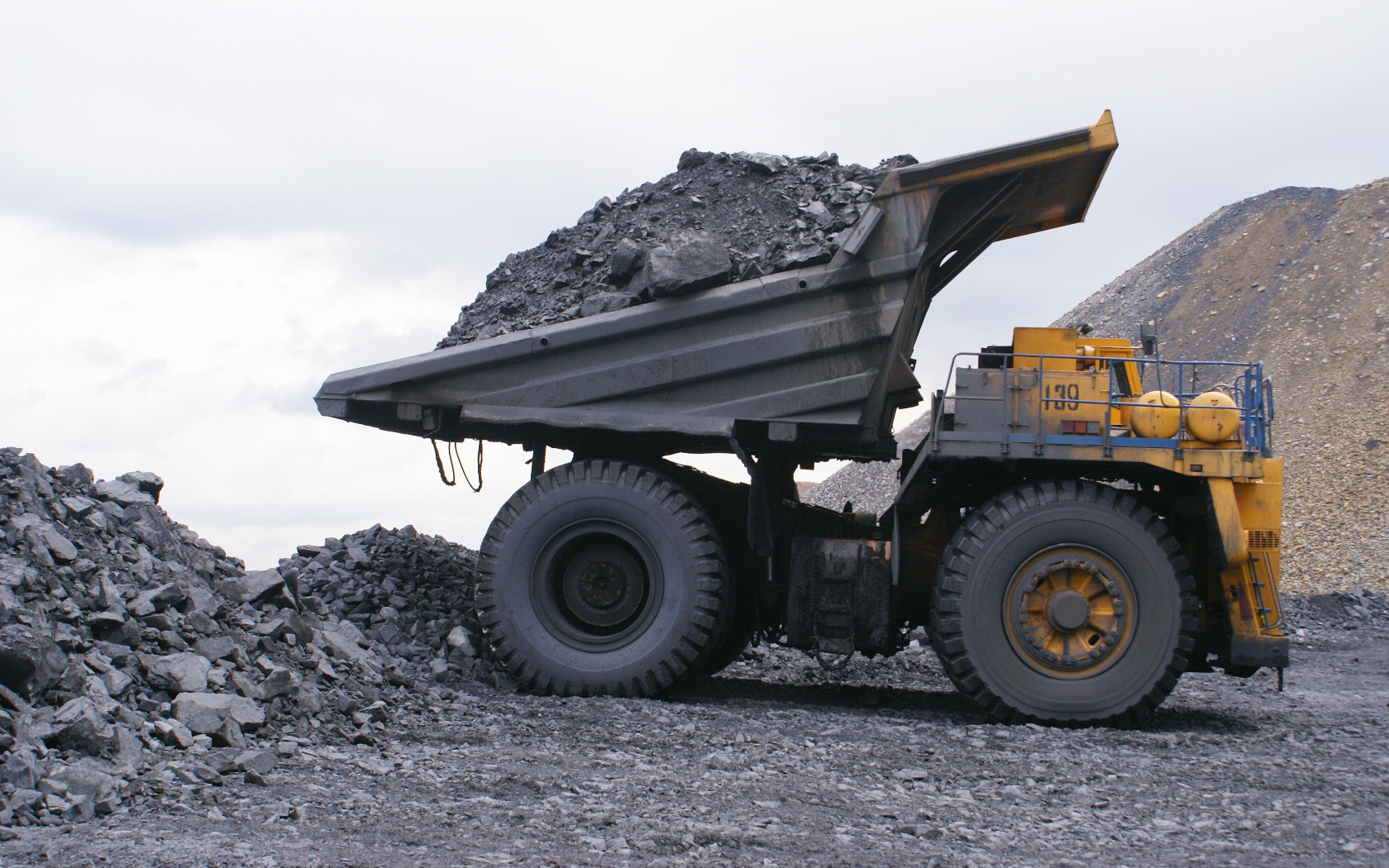


Figure 5.1.2–4 – Coal, oil, and natural gas are all fossil fuels, made from the carbon-rich remains of organisms (mostly plants) that died millions of years ago.
Fossil fuels are the carbon-rich remains of living organisms that died millions of years ago. Contrary to a popular myth, they are almost entirely the remains of plants, not of dinosaurs or other animals.
Fossil fuels have been extremely important to human history and economic development, because they have provided much of the energy that we have used to build our civilization. However, they also have some notable downsides, including the fact that their use leads to air and water pollution, and to global warming. We’ll save further discussion of the impacts of fossil fuels for Chapter 7.
